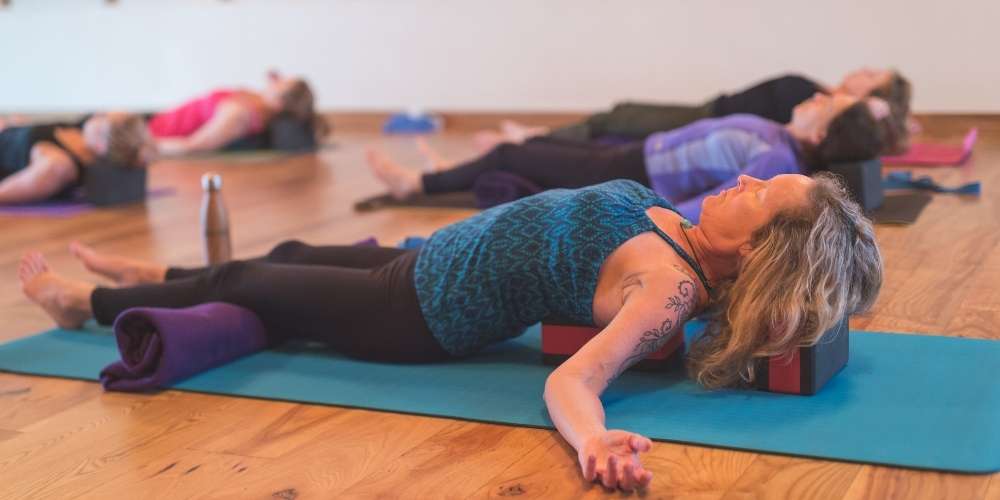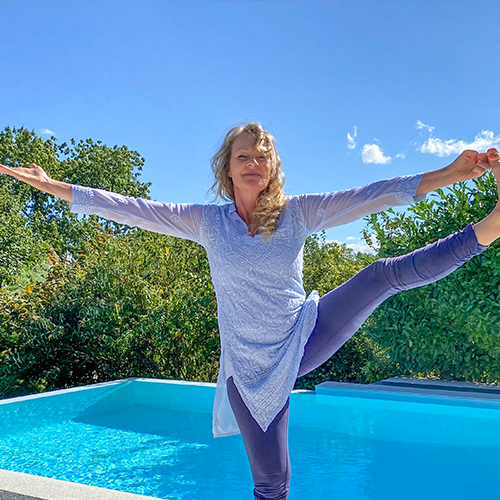The online yoga community has exploded over this past year. So what is all the hype about yoga. During the pandemic fear, anxiety, and stress levels that people experience have soared. Many are turning to yoga to relieve these negative emotions. The advantage is that yoga can be practiced virtually anywhere, at any time and with very little equipment. However, the benefits of yoga play a key role here. Therefore, we have prepared a Top 10 Benefits of Yoga list for you.
So What is Yoga?
Derived from the Sanskrit word “yuji,” meaning yoke or union, yoga is an ancient practice that brings together mind and body. It incorporates breathing exercises, meditation and poses designed to encourage relaxation and reduce stress. Practicing yoga come with many benefits for both mental and physical health. Let’s take a look at benefits of Yoga according to scientific researches.
Top 10 Benefits of Yoga
1. Studies show that yoga can decrease stress.
Yoga can ease stress and promote relaxation. In fact, multiple studies have shown that it can decrease the secretion of cortisol, the primary stress hormone. One study demonstrated the powerful effect of yoga on stress by following 24 women who perceived themselves as emotionally distressed. After a three-month yoga program, the women had significantly lower levels of cortisol. They also had lower levels of stress, anxiety, fatigue and depression.
Another study of 131 people had similar results, showing that 10 weeks of yoga helped reduce stress and anxiety. It also helped improve quality of life and mental health.
When used alone or along with other methods of alleviating stress, such as meditation, yoga can be a powerful way to keep stress in check.

2. Yoga relieves anxiety.
Many people begin practicing yoga as a way to cope with feelings of anxiety. Interestingly enough, there is quite a bit of research showing that yoga can help reduce anxiety.
In one study, 34 women diagnosed with an anxiety disorder participated in yoga classes twice weekly for two months. At the end of the study, those who practiced yoga had significantly lower levels of anxiety than the control group.
Another study followed 64 women with post-traumatic stress disorder (PTSD), which is characterized by severe anxiety and fear following exposure to a traumatic event. After 10 weeks, the women who practiced yoga once weekly had fewer symptoms of PTSD. In fact, 52% of participants no longer met the criteria for PTSD at all.
It’s not entirely clear exactly how yoga is able to reduce symptoms of anxiety. However, it emphasizes the importance of being present in the moment and finding a sense of peace, which could help treat anxiety.

3. Yoga could improve heart health.
From pumping blood throughout the body to supplying tissues with important nutrients, the health of your heart is an essential component of overall health. Studies show that yoga may help improve heart health and reduce several risk factors for heart disease. One study found that participants over 40 years of age who practiced yoga for five years had a lower blood pressure and pulse rate than those who didn’t.
Some research also suggests that incorporating yoga into a healthy lifestyle could help slow the progression of heart disease. A study followed 113 patients with heart disease, looking at the effects of a lifestyle change that included one year of yoga training combined with dietary modifications and stress management. Participants saw a 23% decrease in total cholesterol and a 26% reduction in “bad” LDL cholesterol. Additionally, the progression of heart disease stopped in 47% of patients.
It’s unclear how much of a role yoga may have had versus other factors like diet. Yet it can minimize stress, one of the major contributors to heart disease.

4. Fighting Depression
Some studies show that yoga may have an anti-depressant effect and could help decrease symptoms of depression. This may be because yoga is able to decrease levels of cortisol, a stress hormone that influences levels of serotonin, the neurotransmitter often associated with depression.
In one study, participants in an alcohol dependence program practiced Sudarshan Kriya, a specific type of yoga that focuses on rhythmic breathing. After two weeks, participants had fewer symptoms of depression and lower levels of cortisol. They also had lower levels of ACTH, a hormone responsible for stimulating the release of cortisol.
Other studies have had similar results, showing an association between practicing yoga and decreased symptoms of depression. Based on these results, yoga may help fight depression, alone or in combination with traditional methods of treatment.

5. Yoga could reduce chronic pain.
Chronic pain is a persistent problem that affects millions of people and has a range of possible causes, from injuries to arthritis. There is a growing body of research demonstrating that practicing yoga could help reduce many types of chronic pain.
In one study, 42 individuals with carpal tunnel syndrome either received a wrist splint or did yoga for eight weeks. At the end of the study, yoga was found to be more effective in reducing pain and improving grip strength than wrist splinting.
Another study in 2005 showed that yoga could help decrease pain and improve physical function in participants with osteoarthritis of the knees. Incorporating yoga into your daily routine may be beneficial for those who suffer from chronic pain.

6. Yoga can promote sleep quality
Poor sleep quality has been associated with obesity, high blood pressure and depression, among other disorders. Studies show that incorporating yoga into your routine could help promote better sleep.
In a 2005 study, 69 elderly patients were assigned to either practice yoga, take an herbal preparation or be part of the control group. The yoga group fell asleep faster, slept longer and felt more well-rested in the morning than the other groups. Another study looked at the effects of yoga on sleep in patients with lymphoma. They found that it decreased sleep disturbances, improved sleep quality and duration and reduced the need for sleep medications.
Though the way it works is not clear, yoga has been shown to increase the secretion of melatonin, a hormone that regulates sleep and wakefulness. Yoga also has a significant effect on anxiety, depression, chronic pain and stress — all common contributors to sleep problems.

7. Yoga improves flexibility and balance
Many people add yoga to their fitness routine to improve flexibility and balance. There is considerable research that backs this benefit, demonstrating that it can optimize performance through the use of specific poses that target flexibility and balance.
A recent study looked at the impact of 10 weeks of yoga on 26 male college athletes. Doing yoga significantly increased several measures of flexibility and balance, compared to the control group
.
Another study assigned 66 elderly participants to either practice yoga or calisthenics, a type of body weight exercise. After one year, total flexibility of the yoga group increased by nearly four times that of the calisthenics group
.
A 2013 study also found that practicing yoga could help improve balance and mobility in older adults. Practicing just 15–30 minutes of yoga each day could make a big difference for those looking to enhance performance by increasing flexibility and balance.

8. It can help improve breathing.
Pranayama, or yogic breathing, is a practice in yoga that focuses on controlling the breath through breathing exercises and techniques. Most types of yoga incorporate these breathing exercises, and several studies have found that practicing yoga could help improve breathing.
In one study, 287 college students took a 15-week class where they were taught various yoga poses and breathing exercises. At the end of the study, they had a significant increase in vital capacity. Vital capacity is a measure of the maximum amount of air that can be expelled from the lungs. It is especially important for those with lung disease, heart problems and asthma.
Another study in 2009 found that practicing yogic breathing improved symptoms and lung function in patients with mild-to-moderate asthma.
Improving breathing can help build endurance, optimize performance and keep your lungs and heart healthy.

9. Yoga promotes healthy eating habits.
Mindful eating, also known as intuitive eating, is a concept that encourages being present in the moment while eating. It’s about paying attention to the taste, smell and texture of your food and noticing any thoughts, feelings or sensations you experience while eating.
This practice has been shown to promote healthy eating habits that help control blood sugar, increase weight loss and treat disordered eating behaviors.
Because yoga places a similar emphasis on mindfulness. Some studies show that it could be used to encourage healthy eating behaviors. One study incorporated yoga into an outpatient eating disorder treatment program with 54 patients, finding that yoga helped reduce both eating disorder symptoms and preoccupation with food.
Another small study looked at how yoga affected symptoms of binge eating disorder, a disorder characterized by compulsive overeating and a feeling of loss of control. Yoga was found to cause a decrease in episodes of binge eating, an increase in physical activity and a small decrease in weight.
For those with and without disordered eating behaviors, practicing mindfulness through yoga can aid in the development of healthy eating habits.

10. Yoga can increase strength.
In addition to improving flexibility, yoga is a great addition to an exercise routine for its strength-building benefits. In fact, there are specific poses in yoga that are designed to increase strength and build muscle.
According to a study, 79 adults performed 24 cycles of sun salutations — a series of foundational poses often used as a warm-up — six days a week for 24 weeks. They experienced a significant increase in upper body strength, endurance and weight loss. Women had a decrease in body fat percentage, as well.
A 2015 study had similar findings, showing that 12 weeks of practice led to improvements in endurance, strength and flexibility in 173 participants.
Based on these findings, practicing yoga can be an effective way to boost strength and endurance. Especially when used in combination with a regular exercise routine.

Top 10 Benefits of Yoga: Conclusion
Multiple studies have confirmed the many mental and physical benefits of yoga. Incorporating it into your routine can help enhance your health, increase strength and flexibility and reduce symptoms of stress, depression and anxiety. Finding the time to practice yoga just a few times per week may be enough to make a noticeable difference when it comes to your health.
Ref: www.healthline.com
AUTHOR: ANNE

Hi! I am Anne. I am a fitness and wellness coach with over 25 years of experience in the Swiss Romande area. I am a Yoga Alliance Certified Teacher for 500 hours and for Training Teachers in Continuing Education. I am passionate about helping individuals reach their highest potential and dedicated to attaining and maintaining fulfilment and happiness in every aspect of life.


